TGV
![]()
The title of this article is ambiguous. For other meanings, see TGV (disambiguation).
TGV [teʒe've] (acronym of French train à grande vitesse 'high-speed train') is the name for various series of trains of the manufacturer Alstom, which are used for the high-speed traffic of the French state railway SNCF. The word mark TGV was also used by SNCF as a train type until 2017. To distinguish the trains and the service, connections with the TGV have since been marketed under the brand "inOui" 'outrageous', 'unprecedented'; in addition, services with TGV trains are offered by SNCF under the low-priced brand "Ouigo". Various series of TGV and sibling Thalys and Eurostar International trains operate in France and its neighbouring countries, as well as the Netherlands and the UK. Trains based on the TGV operate in South Korea (KTX) and Spain (Renfe series 100, see below).
TGV trains have set world speed records several times. The maximum speed in regular operation is up to 320 km/h, depending on the line and series. Speeds of this magnitude can generally only be achieved on specially constructed high-speed lines. The total length of these lignes à grande vitesse (LGV) is around 2734 kilometers. The first was opened in 1981 between Paris and Lyon and immediately proved to be a great commercial success. Between the connected cities, travel by TGV has largely replaced air travel due to the time saved.
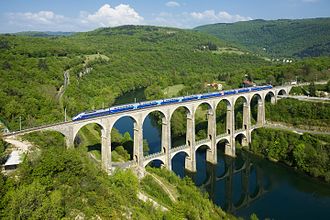
TGV Duplex on the Cize-Bolozon viaduct over the Ain river
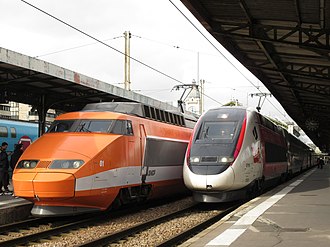
Power car in original colors (TGV Sud-Est) of the pre-production train 01 and TGV Duplex in the color scheme Lyria in the Paris terminus station Gare de Lyon (2020)
History
| Year | Passengers |
| 1981 | 1,26 |
| 1982 | 6,08 |
| 1983 | 9,20 |
| 1984 | 13,77 |
| 1985 | 15,38 |
| 1986 | 15,57 |
| 1987 | 16,97 |
| 1988 | 18,10 |
| 1989 | 19,16 |
| 1990 | 29,93 |
| 1991 | 37,00 |
| 1992 | 39,30 |
| 1993 | 40,12 |
| 1994 * | 43,91 |
| 1995 | 46,59 |
| 1996 | 55,73 |
| 1997 ** | 62,60 |
| 1998 | 71,00 |
| 1999 | 74,00 |
| 2000 | 79,70 |
| 2001 | 83,50 |
| 2002 | 87,90 |
| 2003 | 86,70 |
| 2004 | 90,80 |
| 2005 | 94,00 |
| 2007 | 100,00 |
| 2013 | 125,00 |
| (* from 1994 including Eurostar; | |
Previous story
Early on, France was considered the country of fast trains par excellence. In 1955, the SNCF set the world speed record of 331 km/h for rail vehicles during test runs in southwest France. From 1967, the maximum speed of 200 km/h was introduced in commercial operation, initially between Paris and Toulouse ("Le Capitole") and a little later between Paris and Bordeaux ("L'Aquitaine" and "L'Etendard"). On the latter connection, travel speeds of up to 145 km/h were achieved, which was again a world record for conventional lines. A further increase of the maximum speed to 220 km/h was envisaged for the high-speed sections of the line to Toulouse. This seemed to exhaust the possibilities given with conventional trains and lines.
From the end of the 1950s onwards, among other prestigious technical projects, the development of various rapid transport systems based on new, mostly non-contact transport technologies took shape. In France, the main focus was on the Aérotrain hovercraft until 1974. In parallel, the state railway company SNCF was concerned with the conception of a rapid transit system on conventional steel rails, but with lines and new types of vehicles, some of which had to be built from scratch.
It was originally planned that these "TGV" trains - at that time the abbreviation stood for très grande vitesse 'very high speed', or turbine grande vitesse 'high speed turbine' - should be equipped with gas turbines. The reason for this was, on the one hand, that the line was to be designed as cost-effectively as possible and, on the other hand, that the feasibility of a reliable power supply via the catenary and pantographs at speeds of over 200 km/h was not assured at the time. Gas turbines promised a favourable power-to-weight ratio at a relatively small size and the maintenance of a large power output over a longer period of time. The technology was developed to operational maturity in the experimental vehicle TGS (Turbine à Gaz Spéciale) and subjected to the stresses of everyday operation in the multiple unit series ETG (Elément à Turbine à Gaz) and RTG (Rame à Turbine à Gaz). Like French nuclear technology, the tidal power station at Saint-Malo, Concorde or the passenger ship "France", gas turbine technology was given a high symbolic significance as a showpiece of French engineering.
The first TGV prototype TGV 001, tested from 1972, was designed as a gas turbine train. The exterior appearance (including the distinctive train nose) was designed by the designer Jacques Cooper, as was the interior. The SNCF tested with this train in 5227 test runs the new brakes, which were necessary to be able to dissipate the high kinetic energy in the high-speed range, but also aspects of air resistance and the signalling system. Furthermore, it became clear that Jakobs bogies (placed between two carriages) provide better running smoothness than classic bogies at the two ends of the carriages.
Due to the oil crisis of 1973, however, gas turbine propulsion no longer appeared to be a promising solution, especially since electric traction had become cheaper due to the construction of numerous nuclear power plants. At relatively short notice, the electric test vehicle Zébulon was prepared in 1974, with the help of which a satisfactory solution to the current collection problem could be worked out.
In 1974, President Georges Pompidou gave the go-ahead for the implementation of the TGV concept and Prime Minister Pierre Messmer ordered the necessary funds to be made available for the construction of a first TGV line between Paris and Lyon, which was given the designation LN1 - Ligne Nouvelle 1 (new line 1) (today it is called LGV Sud-Est). Already in December 1976, the construction of this high-speed line, designed only for the TGV, started at Écuisses in the department of Saône-et-Loire. In 1978, the first two pre-series trains were put into service and tested. After further modifications, the first series unit was delivered on April 25, 1980.
Start of operations 1981
On 22 September 1981, President François Mitterrand inaugurated the first section of the new line, and commercial service then began with the timetable change of 27 February 1982. The original customer segment was thought to be business travel. However, the TGV soon established itself with a wider public.
In the first year of operation, there were thirteen hourly connections on weekdays and eight on Sundays. After the line was fully opened, the travel time between Paris and Lyon was reduced to 2 hours. This meant that the TGVs were almost twice as fast as the fastest locomotive-hauled train to date, the famous TEE Mistral, which took 3 hours and 55 minutes. The reduction of the route length between Paris and Lyon from 512 to 429 kilometres also played a large part in this reduction in travel time. With the reduction in travel times, passenger numbers also increased, and this trend has continued to this day. In the first five years of operation, 60 million passengers were transported between 37 cities, with an average market share on the corresponding routes of 57 percent.
Spurred on by the great success of the first high-speed line and the spirit of optimism at the beginning of the Mitterrand era, it was quickly decided to implement further projects, which were put into operation between 1989 and 1994:
- LGV Atlantique (LN2) towards Tours and Le Mans
- LGV Nord-Europe (LN3) to the Belgian border and Calais, with connection to the Eurotunnel built by a private company
- LGV Rhône-Alpes (LN4) east past Lyon to Valence
- LGV Interconnexion Est as eastern bypass of Paris to link LN1 and LN3
Further development
Later, the LGV Méditerranée to Marseille and the LGV Est européenne to Strasbourg followed at somewhat longer intervals. On the Paris-Marseille and Paris-London routes, the TGV has a market share of around 70 percent.
In February 1990, Bombardier launched the TGV Canada project. Based on the results of a preliminary study, the TGV was to be used in Canada between Quebec City and Windsor. At least 300 km/h were to be reached on a double-track high-speed line. According to the manufacturer, TGV projects were also being considered at that time in Australia (Melbourne-Sydney), the USSR (Moscow-Leningrad), Brazil (Rio de Janeiro-São Paulo) and the United States (Dallas-Houston-San Antonio), among others. Attempts by GEC-Alsthom and Siemens in the second half of the 1990s to market blends of ICE and TGV components as part of the Eurotrain joint venture in Taiwan and the People's Republic of China failed.
As of May 28, 2000, TGV trains ran for the first time on non-electrified lines. Two pairs of trains per day ran on the 112-kilometer route from Nantes to Les Sables-d'Olonne. On this section of the line, diesel locomotives were hauled in front of the multiple units. Due to high operating costs, the service was discontinued in December 2004. In September 2003, SNCF celebrated the billionth passenger on the TGV, Thalys and Eurostar networks.
From the beginning of 2004, Internet access was tested on 15 multiple units between Paris, Bordeaux and Pau under the name Clic TGV.
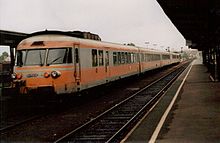
Five-car RTG gas turbine train

A TGV Sud-Est in classic orange (1987)

The TGV logo used from the end of 2000 until July 2012.

Eurotrain , a combination of ICE-2 power cars and TGV Duplex center cars, in Munich in April 1998
Route network
The TGV's route network comprises around 7000 kilometres. Of these, 2734 kilometres are new high-speed lines (as of February 2020). Long-term plans exist for a further 1735 km.
Routes in France
→ Main article: "France" in the high-speed railway article
The French state railway SNCF operates the TGV in regular high-speed service on eight domestic Lignes à grande vitesse (LGV).
The first TGV line to be built is the LGV Sud-Est, which connects Paris with Lyon. The 409 kilometres long line starts at Combs-la-Ville and ends at Sathonay-Camp. It was opened to its full length on September 25, 1983. The 273-kilometre southern section from Saint-Florentin to Sathonay-Camp had already been inaugurated on 22 September 1981. Apart from the main Paris-Lyon-Mediterranean route, this line also provides connections to Dijon-Dole (and on to Besançon, to Bern and to Lausanne (-Brig)), to Geneva, to Annecy, to Chambéry-Mont Cenis-Milan, to Grenoble and to Saint-Étienne.
The LGV Atlantique, which connects Paris with the west of the country, was opened on 24 September 1989, when the 124-kilometre trunk line between Paris-Montparnasse station and Courtalain and the 53-kilometre branch line between Courtalain and Connerré near Le Mans went into service. The 102-kilometer branch line from Courtalain to Monts near Tours followed on September 30, 1990.
The 333-kilometre LGV Nord runs from Paris via Lille to the portal of the Eurotunnel near Calais and provides the link to Brussels and London. The southern section between Arnouville and Arras was opened on 23 May 1993, the northern section on 26 September of the same year.
The LGV Interconnexion Est, which opened on 29 May 1994, is only 57 kilometres long. It bypasses the Paris conurbation to the east and connects the LGV Nord with the LGV Sud-Est, thus enabling connections without transfers. The line starts at Vémars, connects Charles de Gaulle Airport and Disneyland Paris and ends at Coubert. Conventional lines also provide a connection to the LGV Atlantique at Massy TGV station.
The LGV Rhône-Alpes is the continuation of the LGV Sud-Est, which bypasses the Lyon conurbation to the east. The 115-kilometre line starts in Montanay, connects with Lyon Saint-Exupéry Airport and ends near Valence. The first section from Montanay to Saint-Quentin-Fallavier was opened on 13 December 1992, followed by the rest of the line on 3 July 1994.
South of Valence, the LGV Rhône-Alpes is directly followed by the LGV Méditerranée. The line, which went into operation on 1 June 2001, is 250 kilometres long. It starts at Saint-Marcel-lès-Valence and leads to a branch triangle west of Avignon. The western branch ends at Redessan near Nîmes, the eastern branch in the outskirts of Marseille.
The 450-kilometre LGV Est européenne has connected Paris with the east of France since it opened in June 2007. At that time, the 300-kilometer section from Vaires-sur-Marne to Baudrecourt went into operation, while the structural extension of the new line to Strasbourg began in 2010 and was opened in July 2016. Other TGV trains serve Sedan in the Champagne region and Saint-Dié in the Vosges mountains.
The LGV Rhin-Rhône is the first LGV ever that is not oriented towards Paris. It is a diagonal link between eastern and southern France, the first section of the eastern branch went into operation in December 2011. Construction work on the 140-kilometre line between Villers-les-Pots (near Dijon) and Petit-Croix (near Belfort) lasted from July 2006 to 8 September 2011, reducing journey times between Paris and Alsace or Switzerland. Later, the east branch is to be completed, and a south branch and a west branch are also planned.
Two lines were built as a continuation of the LGV Atlantique: The LGV Bretagne-Pays de la Loire between Le Mans and Rennes and the LGV Sud Europe Atlantique between Tours and Bordeaux. They were scheduled to come into service in 2016 and 2017 respectively. Both lines were opened on 2 July 2017. In this context, it was proposed to upgrade the old line from Rennes to Brest and Quimper to a maximum speed of 220 km/h, which, in combination with the use of tilting trains, could reduce the journey time between Paris and the two aforementioned cities on the Atlantic coast to three hours.
Routes outside France
In neighbouring countries, several high-speed lines were built, on which TGV trains and the trains of the Eurostar and Thalys companies run. This created an international high-speed network between Marseille and Paris and on via Lille to London/Brussels-Cologne, as had already been envisaged in the early 1970s - at that time under the name Europolitain.
Eurostar: Great Britain and Belgium
Eurostar trains have been connecting mainland Europe with the British capital London since 1994. As Britain's first high-speed line, a 74-kilometer section of the Channel Tunnel Rail Link has been in operation since September 2003. It starts at the Eurotunnel portal near Folkestone and leads to the Fawkham Junction near Gravesend. The second stage to London's St Pancras station is 34 kilometres long and opened on 14 November 2007. Travel time between Paris and London was reduced to 2 hours 15 minutes, and from London to Brussels to 1 hour 51 minutes.
The Belgian section of the Paris-Brussels link is known as HSL 1. It branches off LGV 3 at Fretin, south of Lille, and ends southwest of the EU metropolis in Halle. Opened on 14 December 1997, the line is 84 kilometres long, of which 71 kilometres are on Belgian territory.
Thalys: Belgium and Germany
As a continuation towards Germany, the new construction projects HSL 2 and HSL 3 were designed. The 63 kilometre long HSL 2 Leuven-Bierset was opened in 2004. Between Brussels and Leuven and between Bierset and Liège, trains run on existing tracks. East of Liège, the existing Liège-Aachen line is being upgraded in the final sections (14 kilometres) and replaced in the 42-kilometre middle section by HSL 3, which was structurally completed in 2007. Since the latter was equipped exclusively with train control (Level 2), its commissioning was delayed until 2009. Before Aachen, the Buschtunnel was extended by a second, single-track tunnel tube. After this was put into operation, the old tunnel, which dates back to the middle of the 19th century, was renovated. The original double-track tunnel was only put back into operation as a single-track tunnel after the renovation was completed. A large part of the line between Aachen and Cologne has already been upgraded (as of April 2012), but the upgrade in the Aachen area is not yet complete. Thalys trains as well as the German ICE 3 are used.
TGV POS: Luxembourg, Germany
Since 9 June 2007, the TGV has been running at a top speed of 320 km/h on the trans-European Paris-East France-South-West Germany (POS) rail link between Paris and Luxembourg via Metz. The following day, the Paris-Stuttgart line via Strasbourg and Karlsruhe was inaugurated. This reduced the travel time between Stuttgart and Paris to 3 hours and 39 minutes. From 9 December 2007, the connection from Stuttgart via Ulm and Augsburg to Munich was extended once a day. Since 24 November 2010, construction has been underway on the second phase of the LGV Est européenne between Baudrecourt and Vendenheim near Strasbourg. The line went into operation on 3 July 2016.
On the ICE route Paris-Saarbrücken-Frankfurt am Main, TGV trains run twice daily in each direction. Since March 2012, a through TGV has been running once a day from Frankfurt am Main to Marseille and in the opposite direction via the TGV route Rhin-Rhône.
From 26 August 2013 to 8 December 2018, a pair of TGV trains ran from Freiburg im Breisgau via Mulhouse (Mulhouse), Belfort, Besançon and Dijon to Paris Gare de Lyon in about 3 hours and 40 minutes. On this occasion, this ran on the LGV Rhin-Rhône and the LGV Sud-Est. Since 9 December 2018, a route via Emmendingen, Lahr, Offenburg and Strasbourg (LGV Est européenne) to the Gare de l'Est has been chosen instead. This connection is about 30 minutes faster.
TGV Lyria: Switzerland
The Paris-Basel-Zurich route via Strasbourg was in operation from 10 June 2007. The journey time from Basel and Zurich to Paris was reduced to 3 and 4 hours 34 minutes respectively. The Rhin-Rhône TGV line has been in operation since December 2011, and this means for the route via Basel: in three hours from Basel and in four hours from Zurich; all trains from Switzerland have been using the Gare de Lyon in Paris since the TGV Rhin-Rhône line came into operation.
All services to Switzerland are now operated by TGV Lyria, a joint subsidiary of SNCF and SBB.
Elipsos: Spain
In December 2010, the LGV Perpignan-Figueres, a 44-kilometre direct connection between Perpignan and the north-eastern Catalan city of Figueres, went into operation. It supplements the curved line via Port Bou along the Mediterranean coast and is also used by freight trains.
The high-speed line between Figueres and Barcelona has been in operation since January 2013. This has made continuous regular-gauge high-speed traffic possible on the Paris-Barcelona-Madrid axis. The cross-border Spanish-French high-speed network was reorganised with the timetable change on 15 December 2013. Since then, Elipsos, a joint venture between Renfe and SNCF, has been responsible for these connections. The trains operate under the name Renfe-SNCF en cooperación / en coopération. The connection between Paris and Barcelona is served three times a day by TGV Duplex trains, for the other lines of this network Renfe multiple units of the series 100, derived from the type "TGV Atlantique" and therefore most easily adapted to operation in France, are used.
Planned routes
As a continuation of the LGV Sud Europe Atlantique on the one hand and as a connection between the Atlantic coast and Nice on the other, there are advanced plans for a LGV Bordeaux-Toulouse. The route, which is estimated to cost four billion euros, is scheduled to open around 2024 and will travel at speeds of up to 360 km/h for the first time. Travel time between Paris and Toulouse will then be reduced to 3 hours and 7 minutes. The LGV Poitiers-Limoges from Poitiers to Limoges will also branch off from the LGV Sud Europe Atlantique. Construction has not yet started, completion is scheduled for 2020 [out of date]. A connection from Bordeaux to Vitoria in northern Spain is also planned. On the French side, the line from Bordeaux to Dax is scheduled to open around 2027 and from there to the border around 2032. In Spain, the new Basque Y line between Vitoria and San Sebastian should be open to traffic before 2020.
Highly controversial, especially among environmental groups, is the route of the planned LGV PACA, short for LGV Provence-Alpes-Côte d'Azur. It is to run from the LGV Méditerranée to Nice and open after 2020[obsolete]. The targeted journey times between Marseille and Genoa are 3 hours 15 minutes. There are also plans to further reduce journey times for services to London via the LGV Picardie, a direct Paris-Calais link via Amiens, without a detour via Lille. The 3.3 to 4.4 billion euro project, which would reduce the journey time between Paris and London to less than two hours, is being lobbied for by local politicians from Amiens in particular, as their city is not yet connected to the TGV network. A 1991 plan also already included the LGV Normandie, which was to run from the Paris suburbs to Mantes-la-Jolie and split into a branch to Rouen and one to Évreux. Due to a poor cost-benefit ratio, this project was shelved. According to the changed plans, the line will now run from Paris beyond Rouen to Le Havre and Caen. Commissioning is scheduled for 2025 at the latest. The most expensive new TGV project is undoubtedly the LGV Lyon-Turin, the heart of which will be the 54-kilometre-long Mont-Cenis base tunnel.

Logo of Renfe-SNCF en cooperación / en coopération

TGV logo of the Lyria subsidiary operated jointly with Swiss Federal Railways

TGV Réseau at Strasbourg-Ville station
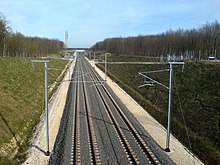
LGV Est at route km 217, near the station in the Département Meuse
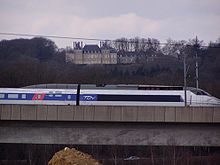
TGV Atlantique before entering the tunnel of Villejust
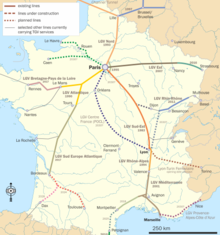
New lines in France
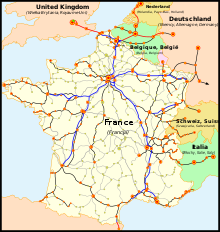
TGV route network blue: new lines in France, red: new lines in neighbouring countries, black: existing lines with TGV traffic, dotted: planned line
Questions and Answers
Q: What is the TGV?
A: The TGV (Train à Grande Vitesse) is a category of high speed trains that are used in France and for some travel between France and other countries.
Q: How fast do TGVs normally travel?
A: TGVs normally travel at speeds between 270 km/h and 320 km/h.
Q: What was the speed record set by a special TGV in 2007?
A: In 2007, a special TGV set the speed record for rail vehicles, reaching 574.8 km/h.
Q: What are some of the high-speed lines inside France?
A: Inside France, there are high-speed lines from Paris to Lyon, Valence, Avignon and Marseille; Paris to Tours and Le Mans; Paris to Poitiers and Bordeaux; Paris to Lille, Brussels (known as Thalys) and Calais, Dover, London (known as Eurostar); Paris to Strasbourg sometimes Frankfurt am Main, Basel and Zürich.
Q: How long does it take to get from Paris to Strasbourg on the TGV?
A: It takes about two and a half hours to get from Paris to Strasbourg on the TGV.
Q: How much of traffic volume is done by airplanes compared with TGVs?
A: Two thirds of the traffic volume is done by TGVs while only one third is done by airplanes.
Search within the encyclopedia